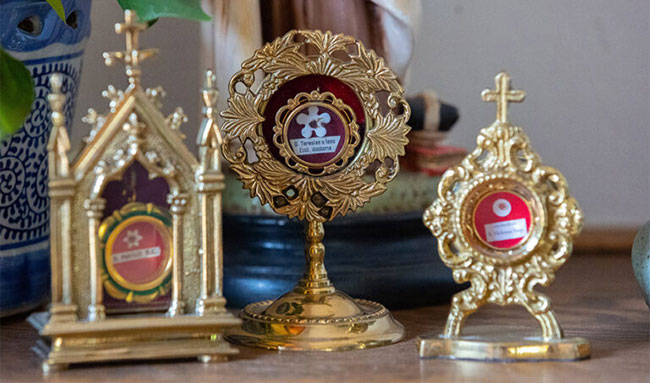
On a visit to the National Shrine of Our Lady of Champion about an hour north of Sheboygan, my son Ben and I were marveling at the fact that the chapel had relics of each of the original Apostles (minus Judas, of course).
In the Catholic Church, a relic is a fragment of the body or physical possession of a canonized saint that can help us grow closer to God.
I was comparing the Saints to the Avengers and asked Ben, “Can you imagine having a relic of Steve Rogers (aka Captain America)? A lock of his hair; a piece of his shield?”
Ben replied, “Except this is even better because these guys actually hung out with Jesus!”
Indeed.
The word relic is derived from the Latin word relinquo – meaning I leave, or I abandon.
Meanwhile, a reliquary is a container that holds and displays the relic.

The Catholic Church recognizes relics as being one of three different classes:
A First Class relic is a body part of a saint, such as bone, blood, hair, or flesh.
Second Class relics are possessions that a saint owned or used during their lifetime, such as clothing, jewelry, bibles, and hand tools. Were Captain America a saint (and also, you know, real), his shield would be a second class relic.
A Third Class relic is any object that has been touched to a first or second class relic or the saint has touched him or herself. This is the only type of relic that the Church permits for sale. Third-class relics are often worn, carried, or kept in the home, for protection, divine guidance, and assistance from their patron saint.
Some people might wonder why anyone would want to own a relic. Well, it’s kind of like how holding onto a loved one’s possessions after they pass away can make us feel closer to them. Owning a relic of a saint is a reminder of a heavenly friend who is a role model of holiness and a powerful intercessor on our behalf.
There are times when a miraculous healing is reported from someone touching a relic. Of course, it’s not as if it is some sort of magic object from an Indiana Jones movie that’s doing the healing; it’s God’s intercession through the object that performs the blessing. It’s reminiscent of the times in the Bible when God healed through the use of physical objects, like when the hemorrhaging woman was cured by grabbing the hem of Jesus’s clothes, or when Jesus spread mud on a blind man’s eyes to restore his sight.
Relics have a long history in the Church!
In the old days, when Catholicism was still illegal under the Roman Empire, early members of the Church would meet in underground catacombs to escape persecution. According to Roman law, burial places were sacred, so cemeteries were generally safe for all citizens. The faithful would celebrate Mass on the stone slabs covering the tombs of martyrs to show reverence for the ultimate sacrifice they made for Christ.
Later, when Emperor Constantine legalized Christianity, Mass no longer needed to be held underground in secret. But in keeping with the tradition of venerating the saints, churches were built over the remains of the martyrs or had a first-class relic placed within the altar.
The relic is there to remind us of the earliest origins of the church, her celebration of the Eucharist, and the remembrance of the incredible witness of those who gave up everything for Jesus.
To this day, every Catholic Church where Mass is celebrated has at least one first-class relic in the altar.
How cool is that?!
References:
https://www.scripturecatholic.com/catholic-relics
https://ucatholic.com/blog/did-you-know-why-every-catholic-altar-contains-relics-of-saints
https://www.catholic.com/tract/relics
https://www.houseofjoppa.com/blogs/news/relics-of-saints-what-you-need-to-know

Leave a Reply